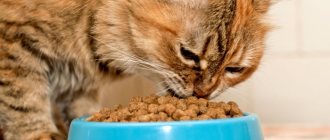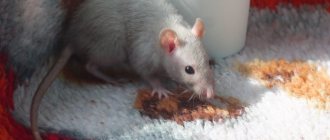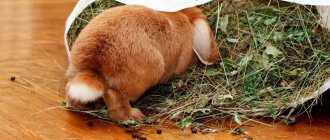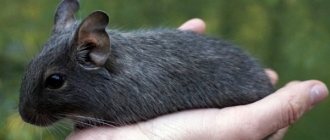Rats make amazing pets. It is not surprising that their owners do everything to ensure that the animals live longer. And the basis of rat well-being is not only good living conditions, but also proper feeding.
Previously, people didn’t think much about what they fed their pet rats. It's a rat! They are omnivores, indestructible, can eat soap, cardboard and sawdust, so why bother with them... As a result, the rats received either a “hamster diet” consisting of a single grain mixture, or a “pig ration” - they were simply given everything from the table. Both approaches are fundamentally wrong.
Properly feeding a rat is not so difficult, you just need to avoid harmful foods and try to maintain a balance of proteins, fats, and carbohydrates. Author of the article: Olga Shiltsova, practicing veterinarian, author of the books “Dachshund of Fate” and “Tails of Fortune”
What do you feed domestic rats: diet composition
A high-quality grain mixture is the basis of the diet of domestic rats. The easiest way is to choose ready-made high-quality food rather than making the mash yourself. Food is given ad libitum, without restrictions. An adult rat eats about 30 grams per day.
In addition to grain, the rat menu must include succulent food - vegetables or fruits, green salads. Protein complementary foods are also needed, especially for young animals during the growth period, pregnant or lactating females.
As a reward for training and just to pamper your pets, they use various seeds and nuts, unsweetened popcorn, banana chips and much more. Treats should make up a tiny part of the diet.
Why does it smell so good?
Domestic rats are fed something like this:
- 60% grain mixture (feed)
- 20% vegetables and unsweetened fruits, greens
- 10% protein food (meat, eggs)
- 5% fermented milk products
- 5% treats
Example of a diet for rats: dry food on the right, protein and succulent food on the left
Now let's take a closer look at each section.
Grain and cereals
Grains are the main product in the diet of rats, but they are not equally important. Wheat is a rich, high-calorie product; it can be given to rats, but it must be taken into account that it must be supplemented with other components. The mixture may include oats, buckwheat, corn, rye, barley or pearl barley, rice, millet or millet. These grains are not equal. Buckwheat is a dietary low-calorie product, and corn, on the contrary. Oats should be added in small quantities; excess may cause fermentation. Refined rice is low in nutrition, so it's worth finding a wild rice blend or an unrefined version of the grain.
Semolina does not contain anything useful, so this product should be excluded from the diet. Barley or wheat cereals are suitable for porridges. Porridge is useful only for weakened, emaciated animals or young animals. Adult rats should only give them as a treat.
Rat food: which one is better?
Grain mixture is the basis of the diet of domestic rats. I advise you to buy only high-quality food, and if this is not possible, prepare the mixture yourself. Unfortunately, domestic inexpensive food has a very poor composition. They consist mainly of oats.
I categorically do not recommend buying food that is stored in cardboard boxes (not airtight), especially in hypermarkets. A rat can easily be poisoned by such food if it was standing, for example, next to washing powder. Opt for imported food in sealed packaging.
Of the two foods, the choice is obvious in favor of Little One, although this is far from the best food for rats
Here are some high-quality foods that can be safely offered to decorative rats:
- Versel-Laga Rat Nature;
- Vitacraft Menu Vital;
- Beaphar Xtra Vital Rat or Care+ Rat Food;
- Vitapol Karma Premium;
- JR Farm Ratten-Schmaus.
Please note that in addition to regular grain mixtures, there are granulated foods for rats. They are similar to complete food for cats and dogs - homogeneous solid “crackers”. Granular feed does not differ from regular feed in composition. They are convenient in the case of selective eating - if rats select seeds and other goodies from the food, leaving the grain uneaten.
Rat food
The basis of the diet should always be cereals: wheat, rye, barley, oats.
Why have a rat at home?
Keeping and caring for a pet rodent does not require any special effort or expenditure of time and money. These small animals are easy to train. Like domestic cats or dogs, they happily greet their owner. They trust their owner completely, as well as the rest of the family, including children.
It should be noted that these animals themselves choose their favorites among the family. Most likely, those who pay the most attention to animals become such favorites. The more often someone picks them up, the faster the animal gets used to it and considers it its owner. At the same time, the animals give all their love and affection, paying tribute to the same love and affection that a person surrounds their pets with.
What fruits and vegetables can rats eat?
Juicy food should be present in the rat menu every day. You should give preference to vegetables and leafy salads; these are healthy and low-calorie foods. Fruits and berries contain a lot of sugars; they are used more as a delicacy.
Rat eats peach slices, blueberries and green beans
You need to feed juicy foods to rats without fanaticism. From a large amount of greens, rat feces become soft and smelly, and even diarrhea is possible. The daily norm is determined individually.
How to give fruits and vegetables to rats:
- Peel the peel;
- Provide local, seasonal fruits;
- Approximate amount per day – 30 g per rat;
- Monitor your stool and well-being, introduce new types of fruits gradually.
In general, it’s better to stick to the “if you’re not sure, don’t give” rule. If one day the rat does not receive succulent food, there will be no trouble.
The following vegetables are fed to rats:
- Zucchini;
- Cucumber;
- Carrot;
- Pumpkin;
- Green salads: arugula, chard, corn, spinach;
- Celery;
- Spicy herbs: dill, parsley, basil.
Excellent assortment: zucchini pieces, lettuce, seeds
What fruits can you give to rats:
- Apricots;
- Bananas;
- Mango;
- Peaches;
- Apples.
In addition to vegetables and fruits, rats enjoy eating berries. However, this is precisely a delicacy, since such fruits contain a huge amount of sugar. Allowed berries:
- Strawberries or wild strawberries;
- Blueberries, blueberries;
- Cherry, sweet cherry;
- Currant;
- Raspberries.
Before giving your rat a new fruit or vegetable, make sure it is not on the list of prohibited foods. Also remember that rats, like people, have food allergies.
Diet and portions
Choosing a pet rat's diet is a very important issue. The number of feedings per day and dosage must be strictly observed.
Under no circumstances should you overfeed your pet - this will lead to obesity, which will have a detrimental effect on the pet’s well-being.
Feeding should take place twice a day and always at the same time. Remembering that rats are more nocturnal, it is better to slightly increase the evening portion. If the daily food intake is fifty grams, then twenty grams are allocated for morning feeding, and thirty grams for evening feeding.
Note! Pregnant and lactating females and young broods need increased nutrition. Therefore, a four-time feeding regimen is established for them. And don't forget about water. Rodents need it constantly.
Can rats eat meat: about protein feeding
Unlike rabbits or guinea pigs, rats are omnivores. A strictly vegetarian diet is bad for their well-being. Adult rats should be given protein-rich food 1-2 times a week, while young rats up to 5 months old should receive it 3-4 times a week.
Many people ask whether rats can eat meat, because they fear that the animal will become “bloodthirsty”, bite fingers, bite a cat, and the like. All these fears are groundless, rats do not become aggressive from meat, and it is necessary to give it. Although rats are delighted with such food, moderation must be observed - a serving of animal protein for an adult rodent is about 20 grams.
Juicy and protein complementary foods in one bowl
The following are used as protein foods:
- Lean boiled meat (beef, turkey, chicken, rabbit)
- Boiled eggs (quail or chicken);
- Boiled fish, squid or shrimp;
- Live and dried insects: grasshoppers, gammarus, zofobas, mealworms.
It is better to give out the meat individually so that the rats do not fight over the tasty morsel. Otherwise, particularly arrogant rats will receive protein overfeeding, while others will experience a lack of nutrients. They serve strictly boiled, not raw meat.
When there are a lot of rats: everyone gets a chicken leg!
As for eggs: boiled yolk can cause a rat to choke. To avoid this, boil the egg soft-boiled or mix the yolk with water. Quail eggs can be given unshelled; rats will eat or peel the shell at their discretion.
Quail eggs are given to rats not because of some “magical properties”, but because of their convenient size
Fish and seafood are rarely given, since these products give urine an unpleasant, specific odor.
Opinions differ regarding insects - there are fears that they can serve as a source of helminthic infestation. However, this is only true for live worms; dried insects are safe. For my part, I agree that it is easier and safer to give your pets a boiled quail egg or a piece of breast than to look for and buy all sorts of larvae.
Peculiarities of nutrition of little rat pups
For the first month after birth, little rat pups feed on their mother’s milk, which after a while is replaced by the food that these animals are accustomed to. The participation of the breeder in the process is practically not required, since the female rodent instinctively knows how to raise babies.
If there are too many offspring, the rat does not have time to look after them all. Then the weakest and most helpless are eliminated through natural selection. For someone who knows what little rat pups eat, it will not be difficult to raise them.
At first, the main food for rat cubs is milk and its derivatives, which are high in vitamins, fats, and beneficial minerals. The best option is dog milk, which, in its absence, can be replaced with goat milk. In addition, small rat pups can be fed with special mixtures.
Important: the transition to artificial nutrition must be carried out smoothly, strictly following the attached instructions, which will prevent oversaturation. Before using the mixture, the water-alkaline balance in babies is restored by taking appropriate medications (for example, Regidron).
- For the first 14 days, feeding is carried out around the clock with a break of 2-3 hours. For 10 gr. weight, the baby needs 0.5 ml of the mixture, which must be prepared before each meal.
- Grown-up rat pups are fed less frequently - every 4 hours, adding low-fat cottage cheese and a little cereal flour to the mixture.
- From the 4th week, rodents can be switched to adult food, but this must be done gradually, without overloading the body.
The scheme for introducing food familiar to rats into the diet of babies is as follows:
- allow the cub to smell and lick new food. You can use a slice of fruit, a boiled egg or a steamed (boiled) vegetable.
- Replace one meal completely with the indicated products, after finely chopping them.
- The next step is to include grains in your diet.
- By the end of the first month of life, the mixture should be completely abandoned, replacing it with other products. However, the baby should be given fermented milk products once a day.
Please note: after taking the mixture, the baby must be given specialized medications to avoid intestinal disorders.
Can rats have milk?
Many rats love fermented milk products. They can also be considered as a source of animal protein, calcium and other benefits. However, many rats cannot digest lactose due to a lack of the enzyme lactase. Dairy products cause strong fermentation in their intestines, and as a result - bloating and diarrhea.
Rats are strictly not given whole milk, as well as dairy products that are too fatty (10-20% sour cream, cream). The best option is fermented milk products with a fat content of up to 5%, without flavorings or any additives. They should not be sweet.
Rats can be given as treats (a dessert spoon of each):
- Cottage cheese;
- Natural yogurt;
- Ryazhenka, acidophilus, narine.
If your pet has not received dairy products before, you need to start with small portions and monitor how you feel afterwards. Fermented milk is given on days when rats do not receive protein complementary foods (meat, eggs), either separately or as a reward.
The clever thief was attracted by the remains of milk at the bottom of the glass
Baits for preparing poison for rats
In order to prepare an effective poison for rats at home (for example, based on Zookoumarin or Krysid), it is advisable to use baits in which the poison can be easily homogenized with the food base.
For example, the following bait bases are good for both rats and mice in this regard:
- Beer, oddly enough, is what rats and mice often cannot resist;
- Milk;
- Meat broth soup;
- Again, raw minced meat, preferably with lard and onions;
- Finely chopped boiled egg;
- Dough with seasonings and spices;
- Boiled porridge, especially with vegetable oil.
Poison is simply added to the food base in the proportions indicated for each drug in the instructions, and the entire mixture is thoroughly mixed. After this, the finished poisoned bait is laid out on a cardboard or saucer (in the case of liquid agents, poured into a plate) and placed where the rats are most likely to quickly find it. All work is carried out wearing rubber gloves.
It is important to take measures to ensure that pets and children cannot reach such bait. This will be discussed in more detail below.
On a note
The vast majority of industrially produced rat poisons are made from dough. Its beauty lies in the fact that the bait turns out to be quite dense, but at the same time not hard, does not fall apart and does not leave marks. In addition, dough briquettes can be easily placed almost anywhere and are much more convenient than bowls of soup or milk.
Take, for example, such products as Mortorat, Rat Death No. 1 and No. 2, Absolon, Ratobor, etc. - these are flavored dough briquettes with blood anticoagulants as the active substance (anticoagulants are one of the most effective rat poisons today). Such a briquette can be placed even in the most inaccessible places, where a saucer with liquid bait will definitely not fit.
However, at home, instead of dough, it is often preferable to use minced meat, which rats love more and which, due to its own strong odor, does not require the addition of flavorings.
A strong smell is also needed to mask the aroma of poison in the bait. Rats are very suspicious and have a very keen sense of smell. If they suspect the presence of a dangerous impurity in a treat (or a human smell), then they will never touch it. Therefore, the stronger the smell of the food base, the greater the likelihood that the rat will be poisoned.
Treats for rats: a little of each
Training animals is incredibly interesting; rats successfully learn various commands. The question arises - how to encourage pets so as not to harm them. And in everyday life, sometimes you want to pamper rats with something tasty.
The main rule: the treat should not be sweet. Therefore, I urge you not to buy “treats” for rodents at the pet store! Milk drops, honey sticks and other crap can be harmful to the health of rats. Moreover, no less tasty things can be found at home.
This cookie is obviously too big
Rats love seeds and nuts! They are given individually, literally one at a time, 1-2 times a week. The point is high fat content and calorie content. Seeds and nuts should not be fried or salted.
- Watermelon, pumpkin, sunflower, flax seeds, sesame seeds;
- Walnuts, hazelnuts, cashews, peanuts.
Rats love all kinds of seeds, but this is too fatty food for them
As a reward, you can use treats made from cereals and cereals:
- Pieces of cereal, unless they are sweet (corn, wheat);
- Tiny crackers dried from regular bread;
- Unsweetened cookies (biscuits);
- Homemade popcorn or puffed rice;
- Pieces of rice paper;
- Pasta;
- Porridges from various cereals.
For repeated rewards, you can dip a stick in yogurt or baby puree and let your rat lick it.
Dumbo rat eats corn
What do rats eat in the wild?
In the wild, food for these rodents is:
- seeds;
- nuts;
- fruits and roots;
- succulent stems of various plants;
- bird eggs;
- insects;
- larvae;
- worms;
- freshwater shellfish;
- fish fry.
Wild rats also love to hunt, so their food can be:
- lizards;
- toads;
- small species of birds and mammals.
However, such a diet predominates in these rodents exclusively during warm periods of the year, since in winter wild rats migrate en masse closer to humans, and in this case any food or its remains become food for them.
In search of food, some groups of rodents can also attack small domestic animals. Such cases are not uncommon, especially in harsh and hungry winters.
Did you know? Due to the physiological characteristics of the body, wild rats are not able to regurgitate products that are indigestible in the gastrointestinal tract. Therefore, before eating anything new, rodents must first try the food and only after a while return to the new product.
What should you not feed your pet rat?
Any products containing salt, sugar, spices, dyes, flavors and preservatives are contraindicated for rats. Therefore, most “human” food is not suitable for them. Chips, sausage, sweets, alcohol, smoked or pickled foods are prohibited.
If mommy eats a cupcake, that's right - we eat a cupcake too!
Foods prohibited due to high fat content (rats have weak livers):
- Sour cream, cream, condensed milk;
- Cheese (yes, cheese is strictly prohibited);
- Lard, bacon;
- Oil.
You should not give vegetables that contain a dangerous toxin - solanine, that is, from the nightshade family:
- Tomatoes;
- Eggplant;
- Bell pepper;
- Potato.
Boiled potatoes can be given, but only occasionally due to their high starch content. There is no point in such a “delicacy”.
You should not give fruits and vegetables that cause gas in the intestines. Such products can be really dangerous for rodents:
- Beans, beans, peas;
- Radish;
- Cabbage;
- Radish;
- Broccoli;
- Turnip;
- Radish (daikon);
- Pears;
- Dried fruits.
Causes intestinal upset (diarrhea):
- Beet;
- Plums.
Fruits that contain large amounts of acids are also contraindicated for rats:
- Any citrus fruits (tangerines, oranges, grapefruits, pomelo);
- Kiwi;
- A pineapple.
Be careful when feeding melons and watermelons to rats due to their high sugar content and the possibility of nitrate poisoning.
You should not give pits containing hydrocyanic acid (apricots, plums, cherries); for the same reason, rats are not given almonds.
Be careful during lunch: if rats are nearby, the game “Give me a piece, man!!!” begins.
What should rodents not eat?
Now you know what to feed your decorative rats. We also figured out how often this should be done. What should you not feed to decorative rats? It is strictly forbidden to give your rodent chocolate or any other sweets. You should not overuse cheese, especially smoked or salted cheese. And, in general, it is strictly forbidden to put any smoked meats in the cage. You also need to know that although vegetables are good for rodents, you should never give them cabbage, sprouted potatoes or any legumes other than corn.
Arrangement of a cage for a decorative rat
A cage for a pet will be very comfortable and cozy if it contains a set of various accessories that provide feeding, odor absorption, play, and relaxation. Therefore, when purchasing a cage, you should immediately purchase elements for its arrangement.
Filler
Basically, rat breeders use corn litter, although it is relatively expensive. It is not recommended to use sawdust as it can cause allergic reactions in rodents. Another option is a filler made from paper napkins or toilet paper. The option is quite cheap, but requires frequent replacement. In this case, you cannot use newspapers and magazines, since your pet can be poisoned by printing ink.
Food bowls
There are hanging bowls that are attached to the bars of the cage. Dry food is poured into them, but for liquid food it is better to purchase heavy ceramic bowls so that the rodent cannot move them.
Drinking bowl
The cage is equipped with a nipple drinker that is safe to use.
Availability of a house
Rodents very often rest, hiding in a small house. The bottom of the house can be covered with a piece of soft material. Such a house can simply be placed at the bottom of the cage or hung up.
Hammock
The pet loves to sleep or just relax in a hammock. It can be hung as high as possible in the cage. You can either buy this accessory at a pet store or make it yourself, if you have something. The hammock needs to be removed and washed often, and after a while it can simply be replaced.
Toilet
As a rule, the animal itself chooses a place in the cage for the toilet, after which a tray or container with high sides is installed in this place. It is advisable to have a filler that will absorb unpleasant odors.
Other accessories
If the cage is spacious enough, then it is permissible to place additional accessories in it in the form of stairs, tunnels, bridges, toys and other elements. House rats simply love to climb on such surfaces.
Decorative rats - care and maintenance | Pet rats
A little history
Cute, affectionate and tame decorative rats are descended from ordinary wild gray rats, which cause a feeling of disgust in humans, as well as a certain fear. This is not at all surprising, since wild rats have gained notoriety not only for their behavior, but also for their ability to spread various viruses and infections.
The Chinese and Indians first became aware of wild rats several thousand years ago. In the 16th century, as maritime trade developed, rats spread throughout the world, moving from continent to continent. In the 19th century in England, these rodents began to be used in battles against dogs, after catching them. During the same period, some hobbyists began breeding rats, especially tame, white ones. Such tame rodents were shown at exhibitions; in addition, white rats took part in circus performances. Some pet lovers started keeping rodents in their homes because they did not pose any danger to humans.
Some of the individuals were used as experimental animals in various laboratories, which is still practiced today, and some of them moved into the homes of scientists. Scientists saw in rats animals that are quite intelligent and attached to humans. Thanks to the crossing of laboratory rats with wild animals, new species and breeds of domestic decorative rodents have appeared, which can still be found among various breeders.











